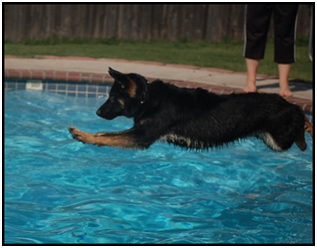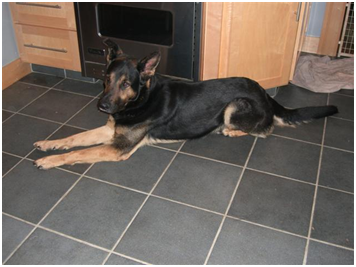It is a challenge
Living with the high-drive dog for many people is very rewarding. However it does have challenges, especially if one is expected to adapt to living in city life. Living with a high-drive dog is not advocated unless there is a plan to devote a fair amount of time to the dog. This includes bonding, dog training and socialising outside of the home.
Often people who are inexperienced with the high-drive working dog do have good intentions when bringing one into their lives. However, a realistic idea of what is required, when living with one, is not always understood or known from the start. Similar to having a child, raising and training the high drive working dog requires an enormous amount of undivided attention during the early stages of their lives. Although many high drive dogs enjoy human companionship, they are more satisfied and do best when exposed to a variety of experiences that encourage them to investigate and thrive in the outside world.
What they are and what they need
Taking time to understand the high-drive working dog’s true nature and needs will ensure a more enjoyable human/canine relationship. They require mental stimulation, an outlet for their high energy, safe chew toys and a safe place for time out. Unless these essentials can be provided, then in all fairness to the dog, a different type is recommended.
Many high-drive dogs show a remarkable amount of intelligence, which makes them a joy to train. However, much of what we consider to be intelligence, is simply pure survival instincts. Unfortunately, most of these instincts manifest as destructive behaviour that will mostly likely cause chaos such as, chasing, chewing, digging, biting, barking, jumping, pulling on the leash, and destroying human possessions etc. These are the same behaviours that make the high-drive dog highly desirable for K-9 service or sports but, they are most certainly difficult to tolerate in normal human society if not managed properly.
Reducing mischievous behaviour by attempting to burn off energy in the high-drive dog is only part of the battle. Driven dogs will replenish their energy within a short period of time and once again, find undesirable ways to occupy themselves. To avoid an unruly behaviour cycle, high-drive dogs need to be challenged through mental stimulation. They do best when given the opportunity to work through tasks while using their natural instincts.
Training them to perform behaviours and tasks through reward-based training is a prime outlet for satisfying their instinctual needs. It is fun and not only challenging for the dog, but the human as well. Maintaining a regular training regiment will help direct the high-drive of the working dog. In addition, the dog will learn boundaries and learn to live a more peaceful life at home.
High-drive dogs must be provided an outlet for their energy, in addition to, mental stimulation. Walks are a convenient form of exercise, but even better, is a situation where the dog can run. Once the dog has a reliable retrieve and recall a good old game of fetch in the park is fun for both human and dog. Off leash hiking and swimming are less convenient but, they are two of the best forms of exercise for a canine buddy.
The best way to learn how to direct the high working drives of a dog is to get involved in dog sports. Dogs thrive on sports, such as agility, obedience, tracking, and flyball to name some of the most popular. Most dog sports involve one on one human and canine interaction, which will further build a strong relationship between handler and dog. In addition, the dog will receive the necessary mental stimulation and exercise while he learns self control. There are numerous opportunities for fun with the high-drive dog. With that said, a dog should be healthy and physically capable before being introduced to a new activity that involves high impact exercises.
Living in the home and manners
High-drive dogs can be a joy to live with in the house. After all,they are pack animals and love being with their family too. However, unless they learn manners, they can be a huge nuisance. During the early years, humans should be vigilant about directing their dog’s energy when they spend time in the home. A variety of low level tasks can be taught in the house. As an example, dogs enjoy working on basic obedience for food such as, sitting, downing, and focusing, etc. They also enjoy learning every day tasks such as, picking up objects off the floor, searching for hidden objects or even learning how to take the laundry from the washer to the dryer. It does not take much to occupy the high-drive dog, but it does require human interaction and some imagination.
Rooms inside the home provide a safe and less distracting area for teaching the beginning of complex obedience exercises. A hallway in the home or galley type kitchen is a great place to start the very beginning retrieve work with a young dog or puppy. Start this work by sitting on the floor and roll a ball 5′ to 10′ away. When the puppy comes back, exchange the ball for food. A toy for toy exchange is less preferable since young dogs have a tendency to become more possessive over toys. Dogs love the challenge of directed activities. Through direction the dog learns boundaries. It is a benefit all around.
Some high drive dogs settle down very nicely in the house and some do not. For the ones who do not they can be taught a “go to place” on the floor. A solid down stay is good for all dogs. They need it for everyday life. The down stay can be taught while doing any task when the human has time to devote a small amount of attention to the dog. A great situation for teaching the “down” is in the kitchen while cooking. The dog can easily be rewarded for lying down in a specific location or on a mat. This teaches the dog to be occupied while staying still. At the same time, if taught using positive reinforcement, the dog’s needs are being met. He is learning to work through his natural survival instincts. He has to do something to earn a reward.
Teaching the dog manners in the house will also be a benefit when dealing with the outside world, for example, down stays are very useful on walks. When stopping and talking with people the dog can stay on a “down”. It will keep him calm and will avoid giving him the opportunity to pull and tug. Also he will not be able to pester people that stop to greet.
Teaching the dog manners ultimately means a more enjoyable relationship. High-drive dogs bring lots of joy to human lives yet, at the same time it takes constant devotion to maintain boundaries. Nothing worth anything is ever easy and it certainly is no different with dogs. It is responsible dog ownership to make sure you are ready for a high-drive dog. Do your research before you purchase or rescue one. The dog you bring into your home should be genetically solid in temperament and health. After that your job will be to socialise, train, be fair to the dog and give him or her a loving home with plenty of attention.

